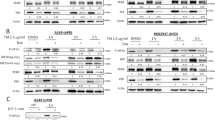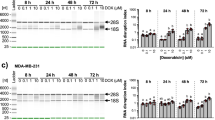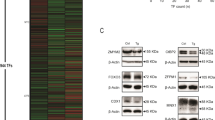Abstract
The aminothiol WR1065 exerts selective cytoprotective effects in normal cells compared to cancer cells and has clinical applications for the protection of normal cells in cancer patients undergoing radio- or chemotherapy. There is evidence that p53 is activated in response to WR1065. To examine the effects of WR1065 on the signalling pathways controlled by p53, isogeneic human colon carcinoma cell lines (HCT116) differing only in the presence or absence of wild-type p53 were used. Treatment with WR1065 resulted in G1 cell cycle arrest in the p53-positive cell line but not in the p53-negative cell line. Long-term exposure resulted in minimal apoptosis of either cell line. Changes in gene expression in p53-positive or -negative cells treated with WR1065 were examined using commercial human stress and cancer gene arrays (Clontech Atlas arrays). Genes found to be specifically upregulated in a p53-dependent manner included coproporphyrinogen oxidase, ICErel-II cysteine protease, macrophage inhibitory cytokine-1 (also known as placental transforming growth factor beta), S100A4, and Waf1/p21. However, most proapoptotic genes typically upregulated by p53 in response to DNA damage were not activated. These studies show that WR1065 specifically modulates a subset of p53 target genes in a colon carcinoma cell line, consistent with the observation that this agent elicits essentially p53-dependent, cell cycle arrest responses.
This is a preview of subscription content, access via your institution
Access options
Subscribe to this journal
Receive 50 print issues and online access
$259.00 per year
only $5.18 per issue
Buy this article
- Purchase on Springer Link
- Instant access to full article PDF
Prices may be subject to local taxes which are calculated during checkout








Similar content being viewed by others
References
Ambartsumian N, Klingelhofer J, Grigorian M, Christensen C, Kriajevska M, Tulchinsky E, Georgiev G, Berezin V, Bock E, Rygaard J, Cao R, Cao Y and Lukanidin E . (2001). Oncogene, 20, 4685–4695.
Baek SJ, Kim K-S, Nixon JB, Wilson LC and Eling TE . (2001). Mol. Pharmacol., 59, 901–908.
Baek SJ, Wilson LC and Eling TE . (2002). Carcinogenesis, 23, 425–434.
Barak Y, Juven T, Haffner R and Oren M . (1993). EMBO J., 12, 461–468.
Bauskin AR, Zhang H-P, Fairlie WD, He XY, Russell PK, Moore AG, Brown DA, Stanley KK and Breit SN . (2000). EMBO J., 19, 2212–2220.
Bootcov MR, Bauskin AR, Valenzuela SM, Moore AG, Bansal M, He XY, Zhang HP, Donnellan M, Mahler S, Pryor K, Walsh BJ, Nicholson RC, Fairlie WD, Por SB, Robbins JM and Breit SN . (1997). Proc. Natl. Acad. Sci. USA, 94, 11514–11519.
Bunz F, Dutriaux A, Lengauer C, Waldman T, Zhou S, Brown JP, Sedivy JM, Kinzler KW and Vogelstein B . (1998). Science, 282, 1497–1501.
Bunz F, Hwang PM, Torrance C, Waldman T, Zhang Y, Dillehay L, Williams J, Lengauer C, Kinzler KW and Vogelstein B . (1999). J. Clin. Invest., 104, 263–269.
Calabro-Jones PM, Fahey RC, Smoluk GD and Ward JF . (1985). Int. J. Radiat. Biol. Relat. Studies Phys. Chem. Med., 47, 23–27.
Capizzi RL . (1996). Eur. J. Cancer, 32A (Suppl 4), S5–S16.
Chang B-D, Swift ME, Shen M, Fang J, Broude EV and Roninson IB . (2002). Proc. Natl. Acad. Sci. USA, 99, 389–394.
Cho Y, Gorina S, Jeffrey PD and Pavletich NP . (1994). Science, 265, 346–355.
Daoud SS, Munson PJ, Reinhold W, Young L, Prabhu VV, Yu Q, LaRose J, Kohn KW, Weinstein JN and Pommier Y . (2003). Cancer Res., 63, 2782–2793.
El-Deiry WS, Tokino T, Velculescu VE, Levy DB, Parsons R, Trent JM, Lin D, Mercer WE, Kinzler KW and Vogelstein B . (1993). Cell, 75, 17–25.
Fuchs SY, Adler V, Buschmann T, Yin Z, Wu X, Jones SN and Ronai Z . (1998). Genes Dev., 12, 2658–2663.
Grigorian M, Andresen S, Tulchinsky E, Kriajevska M, Carlberg C, Kruse C, Cohn M, Ambartsumian N, Christensen A, Selivanova G and Lukanidin E . (2001). J. Biol. Chem., 276, 22699–22708.
Hainaut P and Mann K . (2001). Antioxid. Redox Signal., 3, 611–623.
Hainaut P and Milner J . (1993). Cancer Res., 53, 4469–4473.
Harper JW, Adami GR, Wei N, Keyomarsi K and Elledge SJ . (1993). Cell, 75, 805–816.
Kataoka Y, Murley JS, Khodarev NN, Weichselbaum RR and Grdina DJ . (2002). Int. J. Radiat. Oncol. Biol. Phys., 53, 180–189.
Kaufmann SH, Desnoyers S, Ottaviano Y, Davidson NE and Poirier GG . (1993). Cancer Res., 53, 3976–3985.
Kawaichi M, Ueda K and Hayaishi O . (1981). J. Biol. Chem., 256, 9483–9489.
Kemp G, Rose P, Lurain J, Berman M, Manetta A, Roullet B, Homesley H, Belpomme D and Glick J . (1996). J. Clin. Oncol., 14, 2101–2112.
Lazebnik YA, Kaufmann SH, Desnoyers S, Poirier GG and Earnshaw WC . (1994). Nature, 371, 346–347.
Lee DH, Yang Y, Lee SJ, Kim K-Y, Koo TH, Shin SM, Song KS, Lee YH, Kim Y-J, Lee JJ, Choi I and Lee J-H . (2003). Cancer Res., 63, 4648–4655.
Lee EJ, Gerhold M, Palmer MW and Christen RD . (2003). Br. J. Cancer, 88, 754–759.
Li P-X, Wong J, Ayed A, Ngo D, Brade AM, Arrowsmith C, Austin RC and Klamut HJ . (2000). J. Biol. Chem., 275, 20127–20135.
Liu T, Bauskin AR, Zaunders J, Brown DA, Pankhurst S, Russell PJ and Breit SN . (2003). Cancer Res., 63, 5034–5040.
Malanga M, Pleschke JM, Kleczkowska HE and Althaus FR . (1998). J. Biol. Chem., 273, 11839–11843.
Marzatico F, Porta C, Moroni M, Bertorelli L, Borasio E, Finotti N, Pansarasa O and Castagna L . (2000). Cancer Chemother. Pharmacol., 45, 172–176.
Meier T and Issels RD . (1995). Biochem. Pharmacol., 50, 489–496.
Meplan C, Richard MJ and Hainaut P . (2000). Biochem. Pharmacol., 59, 25–33.
Merwin JR, Mustacich DJ, Muller EG, Pearson GD and Merrill GF . (2002). Carcinogenesis, 23, 1609–1615.
Miyafuji Y, Zhong X, Uchida I, Koi M and Hemmi H . (2001). J. Cell. Physiol., 187, 356–364.
North S, El-Ghissassi F, Pluquet O, Verhaegh G and Hainaut P . (2000). Oncogene, 19, 1206–1214.
North S, Pluquet O, Maurici D, El-Ghissassi F and Hainaut P . (2002). Mol. Carcinogen., 33, 181–188.
Paralkar VM, Vail AL, Grasser WA, Brown TA, Xu H, Vukicevic S, Ke HZ, Hong Q, Owen TA and Thompson DD . (1998). J. Biol. Chem., 273, 13760–13767.
Parks D, Bolinger R and Mann K . (1997). Nucleic Acids Res., 25, 1289–1295.
Pluquet O and Hainaut P . (2001). Cancer Lett., 174, 1–15.
Pluquet O, North S, Bhoumik A, Dimas K, Ronai Z and Hainaut P . (2003a). J. Biol. Chem., 278, 11879–11887.
Pluquet O, North S, Richard M-J and Hainaut P . (2003b). Biochem. Pharmacol., 65, 1129–1137.
Polla BS, Donati Y, Kondo M, Tochon-Danguy HJ and Bonjour J-P . (1990). Biochem. Pharmacol., 40, 1469–1475.
Poplin EA, LoRusso P, Lokich JJ, Gullo JJ, Leming PD, Schulz JJ, Veach SR, McCulloch W, Baker L and Schein P . (1994). Cancer Chemother. Pharmacol., 33, 415–419.
Rainwater R, Parks D, Anderson ME, Tegtmeyer P and Mann K . (1995). Mol. Cell. Biol., 15, 3892–3903.
Shen H, Chen ZJ, Zilfou JT, Hopper E, Murphy M and Tew KD . (2001). J. Pharmacol. Exp. Ther., 297, 1067–1073.
Tan M, Heizmann CW, Guan K, Schafer BW and Sun Y . (1999). FEBS Lett., 445, 265–268.
Tan M, Wang Y, Guan K and Sun Y . (2000). Proc. Natl. Acad. Sci. USA, 97, 109–114.
Verhaegh GW, Richard M-J and Hainaut P . (1997). Mol. Cell. Biol., 17, 5699–5706.
Vousden KH . (2002). Biochim. Biophys. Acta, 1602, 47–59.
Vousden KH and Lu X . (2002). Nat. Rev. Cancer, 2, 594–604.
Waldman T, Kinzler KW and Vogelstein B . (1995). Cancer Res., 55, 5187–5190.
Waldman T, Lengauer D, Kinzler KW and Vogelstein B . (1996). Nature, 381, 713–716.
Yang H, Filipovic Z, Brown D, Breit SN and Vassilev LT . (2003). Mol. Cancer Ther., 2, 1023–1029.
Acknowledgements
We thank Jake Gray for his expert technical assistance in carrying out the Western blots of PTGFβ and Max Kullberg for his critical reading of the manuscript. K Mann was supported by the Biomedical Program at the University of Alaska and P Hainaut by European Community Grant QLG1-1999-00273 and Association pour la Recherche sur le Cancer (ARC) grant within the ARECA programme.
Author information
Authors and Affiliations
Corresponding author
Rights and permissions
About this article
Cite this article
Mann, K., Hainaut, P. Aminothiol WR1065 induces differential gene expression in the presence of wild-type p53. Oncogene 24, 3964–3975 (2005). https://doi.org/10.1038/sj.onc.1208563
Received:
Revised:
Accepted:
Published:
Issue Date:
DOI: https://doi.org/10.1038/sj.onc.1208563
Keywords
This article is cited by
-
Evaluation of potential interactions between the metastasis-associated protein S100A4 and the tumor suppressor protein p53
Amino Acids (2011)
-
Analysis of gene expression profiles in HeLa cells in response to overexpression or siRNA-mediated depletion of NASP
Reproductive Biology and Endocrinology (2009)
-
Improving gene set analysis of microarray data by SAM-GS
BMC Bioinformatics (2007)



